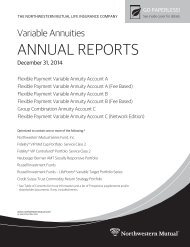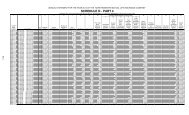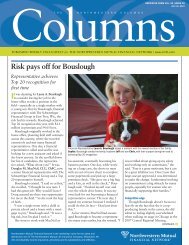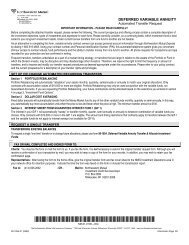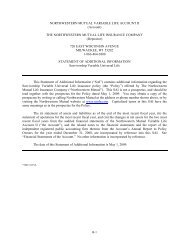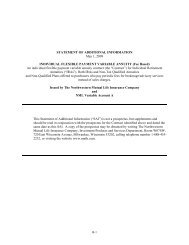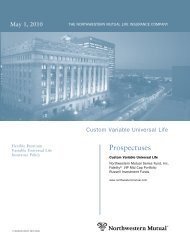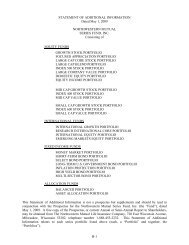commitments with respect to such contracts. As an alternative to segregating assets, a Portfolio maybuy call options permitting such Portfolio to buy the amount of foreign currency being hedged by aforward sale contract or a Portfolio may buy put options permitting it to sell the amount of foreigncurrency subject to a forward buy contract.While forward contracts are not currently regulated by the CFTC, the CFTC may in the futureassert authority to regulate forward contacts. In such event, the Portfolios’ ability to utilize forwardcontracts may be restricted. In addition, a Portfolio may not always be able to enter into forwardcontracts at attractive prices and may be limited in its ability to use these contracts to hedge Portfolioassets.Eurodollar Futures Contracts Or Options Thereon. A Portfolio may make investments inEurodollar futures contracts or options thereon. Eurodollar futures contracts or options thereon areU.S. dollar denominated futures contracts or options thereon which are linked to the LondonInterbank Offered Rate (“LIBOR”), although foreign currency denominated instruments are availablefrom time to time. Eurodollar futures contracts enable purchasers to obtain a fixed rate for the lendingof funds and sellers to obtain a fixed rate for borrowings. A Portfolio might use Eurodollar futurescontracts and options thereon to hedge against changes in LIBOR, to which many interest rate swapsand fixed income instruments are linked.Federal Income Tax Treatment Regarding Futures Contracts. For Federal income tax purposes,each Portfolio is required to recognize as income for each taxable year its net unrealized gains andlosses on futures contracts as of the end of the year as well as those actually realized during the year.Any gain or loss recognized with respect to a futures contract, whether realized or unrealized, isconsidered to be 60% long-term and 40% short-term, without regard to the holding period of thecontract. In the case of a futures transaction classified as a “mixed straddle”, the recognition of lossesmay be deferred to a later taxable year.In order for each Portfolio to continue to qualify for Federal income tax treatment as a regulatedinvestment company, at least 90% of its gross income for a taxable year must be derived fromqualifying income, (i.e., dividends, interest, income derived from loans of securities, and gains fromthe sale of securities). Any net gain realized from the closing out of futures contracts, for purposes ofthe 90% requirement, is expected to be treated as gain from the sale of securities and therefore isqualifying income.Options on Securities and Foreign CurrenciesIn an effort to increase current income and to reduce fluctuations in net asset value, the Portfoliosmay write covered put and call options and buy put and call options on securities that are traded onUnited States and foreign securities exchanges and over-the-counter. The Portfolios may write andbuy options on the same types of securities that the Portfolios may purchase directly, and on security,commodity or other indexes.A put option written by a Portfolio is “covered” if that Portfolio (i) segregates cash not availablefor investment or other liquid assets with a value equal to the exercise price of the put with thePortfolios’ custodian or (ii) holds a put on the same security and in the same principal amount as theput written and the exercise price of the put held is equal to or greater than the exercise price of theput written. The premium paid by the buyer of an option will reflect, among other things, therelationship of the exercise price to the market price and the volatility of the underlying security, theremaining term of the option, supply and demand and interest rates.A call option written by a Portfolio is “covered” if that Portfolio owns the underlying securitycovered by the call or has an absolute and immediate right to acquire that security without additionalcash consideration (or for additional cash consideration held in a segregated account by thePortfolios’ custodian) upon conversion or exchange of other securities held in its portfolio. A calloption is also deemed to be covered if a Portfolio holds a call on the same security and in the sameB-18
principal amount as the call written and the exercise price of the call held (i) is equal to or less thanthe exercise price of the call written or (ii) is greater than the exercise price of the call written if thedifference is maintained by that Portfolio in cash and other liquid assets in a segregated account withits custodian.The Portfolios also may write call options that are not covered for cross hedging purposes. APortfolio collateralizes its obligation under a written call option for cross hedging purposes bysegregating cash or other liquid assets in an amount not less than the market value of the underlyingsecurity, marked-to-market daily. A Portfolio would write a call option for cross hedging purposes,instead of writing a covered call option, when the premium to be received from the cross-hedgetransaction would exceed that which would be received from writing a covered call option and itsportfolio manager believes that writing the option would achieve the desired hedge.The writer of an option may have no control over when the underlying securities must be sold, inthe case of a call option, or bought, in the case of a put option, since with regard to certain options,the writer may be assigned an exercise notice at any time prior to the termination of the obligation.Whether or not an option expires unexercised, the writer retains the amount of the premium. Thisamount, of course, may, in the case of a covered call option, be offset by a decline in the market valueof the underlying security during the option period. If a call option is exercised, the writer experiencesa profit or loss from the sale of the underlying security. If a put option is exercised, the writer mustfulfill the obligation to buy the underlying security at the exercise price, which will usually exceed thethen market value of the underlying security.The writer of an option that wishes to terminate its obligation may effect a “closing purchasetransaction”. This is accomplished by buying an option of the same series as the option previouslywritten. The effect of the purchase is that the writer’s position will be canceled by the clearingcorporation. However, a writer may not effect a closing purchase transaction after being notified ofthe exercise of an option. Likewise, an investor who is the holder of an option may liquidate itsposition by effecting a “closing sale transaction”. This is accomplished by selling an option of thesame series as the option previously bought. There is no guarantee that either a closing purchase or aclosing sale transaction can be effected.In the case of a written call option, effecting a closing transaction will permit a Portfolio to writeanother call option on the underlying security with either a different exercise price or expiration dateor both. In the case of a written put option, such transaction will permit a Portfolio to write anotherput option to the extent that the exercise price is secured by other liquid assets. Effecting a closingtransaction also will permit a Portfolio to use the cash or proceeds from the concurrent sale of anysecurities subject to the option for other investments. If a Portfolio desires to sell a particular securityfrom its portfolio on which it has written a call option, such Portfolio will effect a closing transactionprior to or concurrent with the sale of the security.A Portfolio will realize a profit from a closing transaction if the price of the purchase transactionis less than the premium received from writing the option or the price received from a sale transactionis more than the premium paid to buy the option. A Portfolio will realize a loss from a closingtransaction if the price of the purchase transaction is more than the premium received from writingthe option or the price received from a sale transaction is less than the premium paid to buy theoption. Because increases in the market of a call option generally will reflect increases in the marketprice of the underlying security, any loss resulting from the repurchase of a call option is likely to beoffset in whole or in part by appreciation of the underlying security owned by a Portfolio.An option position may be closed out only where a secondary market for an option of the sameseries exists. If a secondary market does not exist, the Portfolio may not be able to effect closingtransactions in particular options and the Portfolio would have to exercise the options in order torealize any profit. If a Portfolio is unable to effect a closing purchase transaction in a secondarymarket, it will not be able to sell the underlying security until the option expires or it delivers theunderlying security upon exercise. The absence of a liquid secondary market may be due to theB-19
- Page 4: APPENDIX F - Proxy Voting Policies
- Page 9 and 10: stocks that make up that index. Str
- Page 11 and 12: Interest rate swaps do not involve
- Page 13 and 14: the Adviser or Sub-Adviser will not
- Page 17: Forward Contracts. The Portfolios m
- Page 21 and 22: Options on Foreign Currencies. The
- Page 23 and 24: securities. The issuers of the unde
- Page 25 and 26: the former pools. However, timely p
- Page 27 and 28: CMO residuals are generally purchas
- Page 29: utilize the underlying assets may r
- Page 32 and 33: include range floaters which are a
- Page 34 and 35: par unless the price of the underly
- Page 36 and 37: to changes in interest rates genera
- Page 38 and 39: corresponding floaters. The underly
- Page 40 and 41: A Portfolio will not enter into suc
- Page 42 and 43: egulations. The presence of an issu
- Page 44 and 45: Portfolio TurnoverPortfolio turnove
- Page 46 and 47: The ability of the Portfolio to ach
- Page 48 and 49: Advisors, LLC, in accordance with t
- Page 50 and 51: OWNERSHIP OF SHARES OF THE FUNDAll
- Page 52 and 53: on the next $50 million, 0.50% on t
- Page 54 and 55: Independent Registered Public Accou
- Page 56 and 57: Name of Portfolio 2008 2007 2006Int
- Page 58 and 59: Broker High Yield Bond BalancedAsse
- Page 60 and 61: and cost of trade execution of Port
- Page 62 and 63: Effective April 30, 2008, the Fund
- Page 64 and 65: TAXES AND DIVIDENDSEach Portfolio i
- Page 66 and 67: APPENDIX A - Credit RatingsDescript
- Page 68 and 69:
F2Good credit quality. A satisfacto
- Page 70 and 71:
. Moody’s Commercial Paper (short
- Page 72 and 73:
Plus (+) or minus (-)The ratings fr
- Page 74 and 75:
APPENDIX B - Directors and Officers
- Page 76 and 77:
Name, Address, andYear of BirthDavi
- Page 78 and 79:
APPENDIX C - Ownership of Shares of
- Page 80 and 81:
SMALL CAP VALUE PORTFOLIOGeneral Ac
- Page 82 and 83:
APPENDIX D - Portfolio ManagersOthe
- Page 84 and 85:
PortfolioManager(s)FundRegisteredIn
- Page 86 and 87:
Compensation of Portfolio ManagersM
- Page 88 and 89:
management firms. Performance is pr
- Page 90 and 91:
Portfolio managers are eligible for
- Page 92 and 93:
PortfolioPortfolio Manager(s)Dollar
- Page 94 and 95:
On August 25, 2005, the Court enter
- Page 96 and 97:
MSA’s Equity Trading Department s
- Page 98 and 99:
ERISA ClientsIn the case of client
- Page 100 and 101:
Shareholder Ability to Call Special
- Page 102 and 103:
• Exercise price• Participation
- Page 104 and 105:
Amend Quorum RequirementsVote propo
- Page 106 and 107:
Vote proposals to increase blank ch
- Page 108 and 109:
employees of Investment Manager and
- Page 110 and 111:
will not support the position of a
- Page 112 and 113:
company specifies the voting, divid
- Page 114 and 115:
egarding whether Investment Manager
- Page 116 and 117:
3. The issuer is an entity particip
- Page 118 and 119:
manager(s) are responsible for maki
- Page 120 and 121:
Global Corporate Governance: Invest
- Page 122 and 123:
13. The Proxy Group will review the
- Page 124 and 125:
determined by those investment comm
- Page 126 and 127:
T. Rowe Price has adopted these Pro
- Page 128 and 129:
shareholders and the effect on shar
- Page 130 and 131:
portfolio company could have influe
- Page 132 and 133:
The Proxy Voting Service will refer
- Page 134 and 135:
that substantially differs from dom
- Page 136 and 137:
15. Janus will generally vote in fa
- Page 138 and 139:
46. For shareholder proposals outsi
- Page 140 and 141:
2. Staggered BoardIf a company has
- Page 142 and 143:
proposed for a legitimate business
- Page 144 and 145:
APPENDIX G - Portfolio Holdings Dis
- Page 146:
ICP Securities LLCIntermonte Securi



